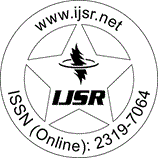Downloads: 142 | Weekly Hits: ⮙1 | Monthly Hits: ⮙1
Research Paper | Medicine Science | India | Volume 4 Issue 10, October 2015
Biologically Synthesized Silver Nanoparticles from Latex of Syandenium grantii and Fresh Leaves of Kalanchoe pinnata: Potential Source of Cytotoxic Agents against Cervical Cancer Cells
Pratik Durgawale | Rohan Phatak | Kailas Datkhile | Anup Hendre | Pushpa Durgawale
Abstract: Nanotechnlogy has become ubiquitous in every stream of science today. Biomedicine is no exception to this phenomenon. Metallic nanoparticles have been synthesized, characterized and utilized in biomedicine for imaging, wound healing and targeted drug delivery. A further improvement is the introduction of green nanotechnology wherein the plant extracts are used to synthesize nanoparticles. This preparation technique has added advantages of being relatively easy, economical and faster as compared to the traditional chemical techniques. A number of studies have been reported wherein the aqueous plant extracts are used to synthesize metallic nanoparticles of varying sizes, shapes and biochemical potencies. Most of the green nanoparticles have anti-oxidative, anti-microbial and anti-cancer activities. Here, we compare the anti-cancer property of different silver nanoparticle samples synthesized using two different plant extracts from Syandenium grantii and Kalanchoe pinnata using the human cervical cancer cell line HeLa. The cell viability assay was carried out using the Trypan blue dye exclusion method, while cytotoxicity was compared using the MTT assay. These nanoparticles have been earlier demonstrated to have anti-microbial, anti-oxidative properties and this study supports its anti-cancer activity.
Keywords: Green chemistry, silver nanoparticles, anti-cancer, cytotoxicity
Edition: Volume 4 Issue 10, October 2015,
Pages: 340 - 343
Similar Articles with Keyword 'anticancer'
Downloads: 111
Research Paper, Medicine Science, Indonesia, Volume 5 Issue 1, January 2016
Pages: 1619 - 1623High Antitumor Activity of Ethanolic Extracts of Papua's Ant Nest Plant (Myrmecodia tuberosa) on an Oral Carcinoma (KB) Cell Line
Sartari Entin Yuletnawati [3] | Edi Meiyanto | Dewi Agustina
Downloads: 116 | Weekly Hits: ⮙1 | Monthly Hits: ⮙1
Research Paper, Medicine Science, Egypt, Volume 4 Issue 2, February 2015
Pages: 2170 - 2176Potential Toxicity of Egyptian Ashwagandha: Significance for their Therapeutic Bioactivity and Anticancer Properties
Wafaa Abdallah Ahmed | Mohamed A. [19] | Nasser E. A. | Doaa E.
